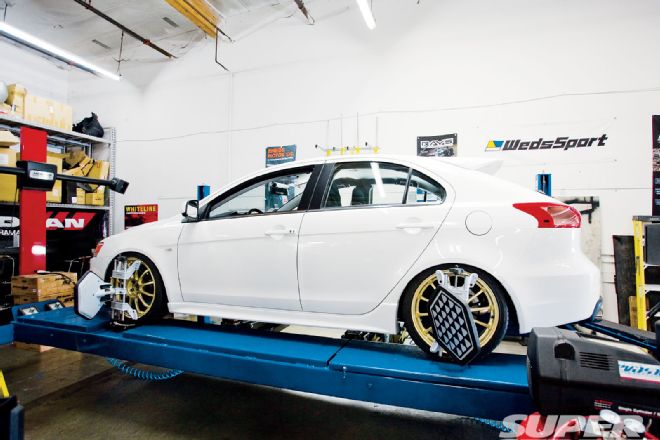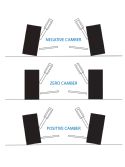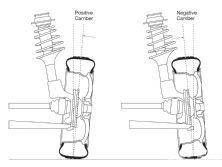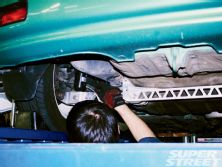We all know that having the right tires makes all the difference in the way a car performs, but to truly get the most from your tires they need to be properly aligned. There is often a lot of confusion involved with what the different settings mean and how they affect the handling of your car. Fortunately, we're here to help guide you through it. It just so happened that my track project EK Leroy was due for an alignment after installing some new suspension components so I headed over to Evasive Motorsports in La Puente, CA and got sorted out.
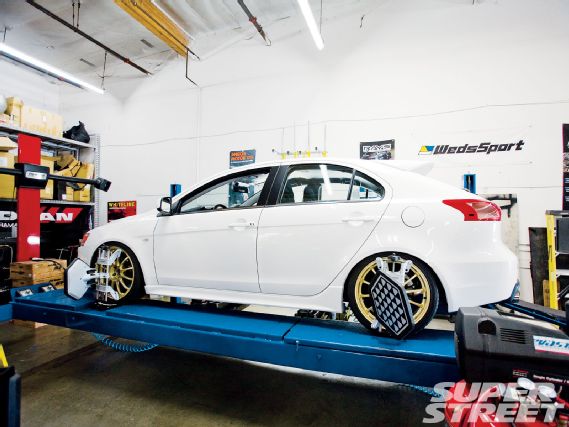 |
Headed In The Right Direction - Tech
|
Headed In The Right Direction - Tech
Caster
What is it?
Caster is the angle at which the steering axis is displaced from vertical when viewed from the side, i.e. the angle measured from the upper strut mount to the lower ball joint on a McPherson strut vehicle or from the upper ball joint to lower ball joint on a dual-wishbone suspension.
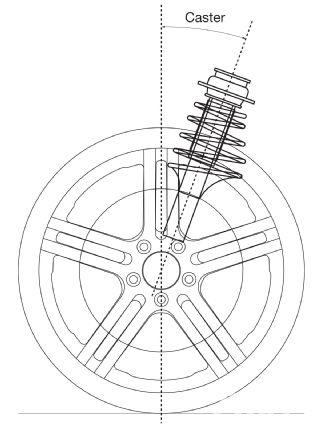 |
Headed In The Right Direction - Tech
|
Headed In The Right Direction - Tech
How does it affect my car?
Caster is responsible for the auto-correcting behavior of the steering creating a stable straight-line characteristic. Caster also affects initial turn-in. The more negative caster a car has the more steering effort is required. Additionally as caster is added, it directly affects the camber of a car while turning.
How do I adjust it?
Very few cars have adjustable caster stock but some McPherson strut vehicles have aftermarket options available typically allowing adjustment via the upper strut mount. For most other vehicles a custom knuckle is required to adjust caster but aside from competition vehicles this setting is rarely altered.
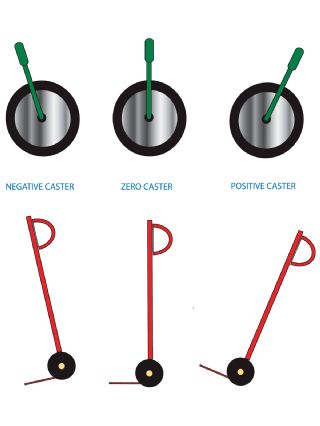 |
Headed In The Right Direction - Tech
|
Headed In The Right Direction - Tech
Toe
What is it?
Toe is the measurement of two wheels on the same axis when viewed from above. Toe in is also referred to as positive toe and indicates that both wheels are pointed inward towards the centerline of the car when moving forward, conversely toe out or negative to is when the wheels are pointed outward from the center of the car when moving forward.
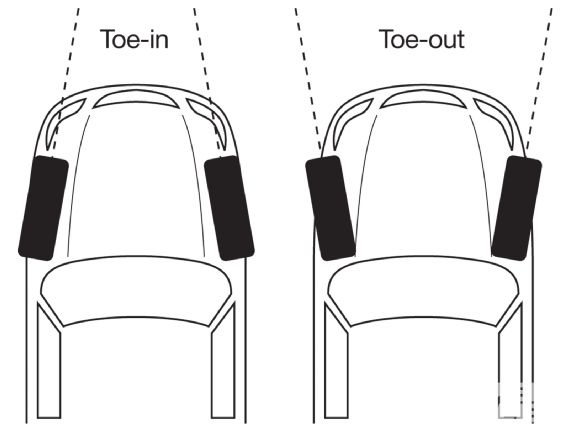 |
Headed In The Right Direction - Tech
|
Headed In The Right Direction - Tech
How does it affect my car?
Aside from being the main culprit in tire wear toe actually has a great affect on the handling characteristics of a car. Toe in at the front increases straight line stability but makes turn-in more sluggish, toe out in the front does exactly the opposite. Generally street cars have a slight degree of toe in at the front while racecars usually have a slight degree of toe out. Toe has essentially the same affect on the rear as it does on the front, however it's rare even on race vehicles to see the use of tow out in the back because it has a tendency to cause oversteer, it's usually a very slight degree of toe in or zero toe.
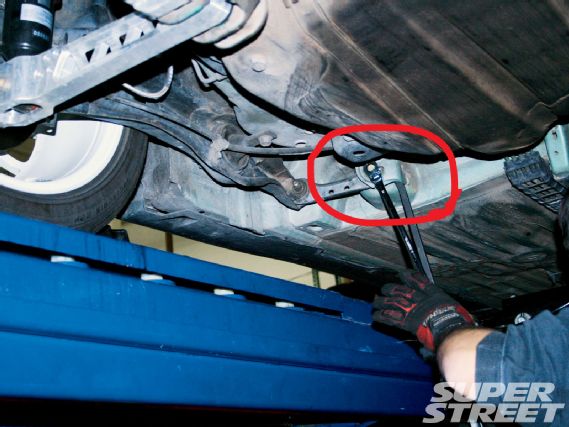 |
Here's a shot of Kel adjusting the rear toe on Leroy. The bolt he's adjusting slides inside a channel and changes the toe by moving the whole trailing arm. Since I rarely drive Leroy on the street he set me up with a fairly aggressive zero toe rear setting.
|
Here's a shot of Kel adjusting the rear toe on Leroy. The bolt he's adjusting slides inside a channel and changes the toe by moving the whole trailing arm. Since I rarely drive Leroy on the street he set me up with a fairly aggressive zero toe rear setting.
How do I adjust it?
Every car has adjustable toe from the factory and when you take your car to a typical alignment shop this is usually the only setting the will (or in many cases can) adjust. The front is adjusted through the tie rods on vehicles with a steering rack while the rear is often adjusted via eccentric bolts or a sliding channel.
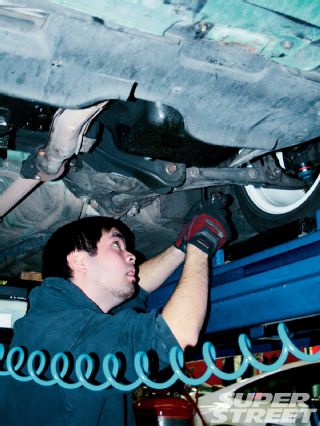 |
Next it was time to perfect the front toe. Again for track purposes we aligned the car with -1/32" of toe out on each side.
|
Next it was time to perfect the front toe. Again for track purposes we aligned the car with -1/32" of toe out on each side.
Camber
What is it?
Camber is angle displacement from vertical of a wheel when viewed from the front or rear of the vehicle. Positive camber describes a wheel that is leaning away from the car at the top while negative camber is leaning inward at the top.
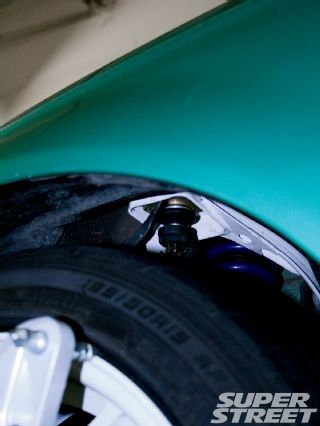 |
It's a little tricky to see but in this shot Kel has already loosened the difficult to reach hardware on top of the control arm and is now sliding the ball joint with a pry bar. Most alignment shops are not equipped to deal with modified camber settings but most specialty race prep shops like Evasive should be able to get you setup, thanks largely to their state-of-the-art laser alignment machine which allows precise adjustments even while the car is raised (as mine is in this picture so he could reach the locking screws). The front camber was set to -2.5 degrees.
|
It's a little tricky to see but in this shot Kel has already loosened the difficult to reach hardware on top of the control arm and is now sliding the ball joint with a pry bar. Most alignment shops are not equipped to deal with modified camber settings but most specialty race prep shops like Evasive should be able to get you setup, thanks largely to their state-of-the-art laser alignment machine which allows precise adjustments even while the car is raised (as mine is in this picture so he could reach the locking screws). The front camber was set to -2.5 degrees.
How does it affect my car?
Camber mostly affects grip via contact patch but can also be responsible for abnormal tire wear when adjusted in excess. Under cornering loads a tire has a tendency to roll under the rim (deflection) causing loss of traction. This can be combated using negative camber to ensure a proper contact patch under load. Different cars require different settings, for example a McPherson Strut type suspension looses camber under load thus requiring a more negative setting than a dual-wishbone design that gains camber under load.
How do I adjust it?
Most cars do not have adjustable camber stock but almost every tuner car has some form of adjustable aftermarket kit available. On McPherson Strut cars the front is usually adjusted with the upper mount on aftermarket coilovers or through an eccentric bolt at the lower shock mount. On dual wish-bone cars the front is typically adjusted via the upper ball joint on the upper control arm or in some cases relocating the inner bushings on the control arm. The rear on multi-link suspension is usually adjusted via a tie-rod style joint on an aftermarket link.

